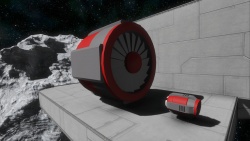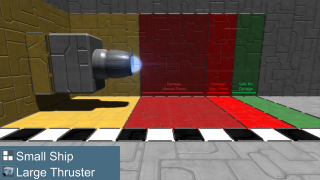推进系统
推进器是所有飞船或者是没有空间锚的空间站移动的主要方式。推进器可以提供飞船一个线性的推力而不会因为所处飞船位置的不同而产生力矩、扭转和旋转(陀螺仪)。只要推进器被连接至了一个整体(而不是异整体或者通过起落架而连接整体),他们都会从整体的质量中心提供推力,因此推进器的摆放位置还是稍有讲究的。游戏中有两种常尺度推进器: 标准推进器,一种使用电力 的离子推进器;氢推,一种使用氢气作为燃料,更为强劲但使用局限也较大的推进器。 在Update 01.105前,推进器有两个模式:常尺度推进和惯性抑制。常尺度推进用于鼠标和键盘操作的人工航行和控制速度(thrust override slider),惯性抑制则会自动额外消耗50%的电力以提供10倍的惯性抑制力。推进器在惯性抑制打开并且飞船仍在凭借惯性前行的情况下会发挥作用并逐渐使船停下。因此在此次更新前,让船停下会比让船加速更为容易。
Before Update 01.107, all Small Ship thrusters would receive a 5x boost to thrust when under the automatic control of inertial dampeners (not the player or 'thrust override') attempting to stop the ship, for no increase in both power usage or fuel usage.
Currently all kinds of thrusters (whether small or large ship) do not have any special super-dampening capabilities beyond their rated maximum thrust and power consumption.
推进器
| 推进装置 | 方块尺寸(长×宽×高) | 体积 立方米(m³) |
最大推力 千牛(kN) |
质量 千克(kg) |
最大功耗 千瓦(kW) 升/秒(L/s) |
推力质量比 千牛/千克(kN/kg) |
推力大小 千牛/方(kN/m³) |
燃料推力 千牛/千瓦(kN/kW) 千牛/小时(kN/H) |
能源消耗量 亨利/秒(H/s 千克铀/秒(Kg of U/s) | ||
|---|---|---|---|---|---|---|---|---|---|---|---|
| |
Large Thruster 大型离子推进器 |
|
3x4x2 | 375.000 | 3600 | 43200 | 33600 | 0.0833 | 9.6 | 0.1071 | 0.0093 kg |
| |
3x4x2 | 3.000 | 144 | 721 | 2400 | 0.1997 | 48 | 0.060 | 0.00067 kg | ||
| Small Thruster 小型离子推进器 |
|
1x2x1 | 31.250 | 288 | 4384 | 3360 | 0.0657 | 9.216 | 0.0857 | 0.00093 kg | |
| |
1x2x1 | 0.250 | 12 | 93 | 201 | 0.1290 | 48 | 0.0597 | 0.000056 kg | ||
| |
Large Hydrogen Thruster 大型氢气推进器 |
|
3x3x3 | 421.875 | 6000 | 6940 | 4820 | 0.8646 | 14.222 | 0.9336 | 6,426.7 H |
| |
3x3x3 | 3.375 | 400 | 1222 | 368 | 0.3273 | 118.5185 | 0.778 | 514.1 H | ||
| |
Small Hydrogen Thruster 小型氢气推进器 |
|
1x1x1 | 15.625 | 900 | 1420 | 803 | 0.6338 | 57.6 | 0.8238 | 1,092.5 H |
| |
1x1x1 | 0.125 | 82 | 334 | 80 | 0.2455 | 656 | 0.7505 | 109.2 H | ||
| |
Large Atmospheric Thruster 大型空气推进器 |
|
3x3x5 | 703.125 | 5400 | 33834 | 16360 | 0.1596 | 7.68 | 0.3301 | 0.00454 kg |
| |
3x3x5 | 5.625 | 408 | 4244 | 2400 | 0.0961 | 72.53 | 0.1700 | 0.00067 kg | ||
| |
Small Atmospheric Thruster 小型空气推进器 |
|
1x1x3 | 46.875 | 420 | 4072 | 2360 | 0.1031 | 8.96 | 0.1780 | 0.000656 kg |
| |
1x1x3 | 0.375 | 80 | 539 | 701 | 0.1484 | 213.33 | 0.1141 | 0.000195 kg | ||
离子推进器
- 离子推进器使用电力作为能源产生推力。
- 离子推进器的功率消耗与其运行效率的百分比成线性关系,有效性与大气密度成反比,在行星大气外的任何地方的实际效率至少在30%到100%之间,大气密度越高效率越低。
- 即使启动了推进器而不使用,每个推进器仍至少要消耗0.002千瓦(2瓦)电力
空气推进器
- 空气推进器使用电力作为能源产生推力
- 空气推进器的功率消耗与其运行效率的百分比成线性关系,有效性与大气密度成正相关,并且只能于大气中运作。通常情况下几乎不会达到其最大额定效率,只能在90%左右。
- 即使启动了推进器而不使用,每个推进器仍至少要消耗0.002千瓦(2瓦)电力
氢气推进器
- 氢气推进器不消耗电力,仅使用氢来运作。但是相关的氢气制造、存储、输送设备仍然要消耗电力。
- 氢气推进器的运行效率完全不受大气影响。
- 所有的氢气动力推进器都需要使用输送机或输送管连接至氢气来源输送氢气(例如氢气/氧气制造机或氢气罐)。
- 即使启动了推进器而不使用,每个推进器仍至少要消耗少量氢。
常规重力下的有效性
以下公式表示了需要多少推进器才能使一艘飞船在自然重力下悬停于空中:
升力(kg) = 引擎动力(N) × 功效 / 重力加速度(m/s²)
例:1个大型的小型飞船推进器在海平面上的动力是408000N,并假设其运行效率只有90%。
则在类地行星的海平面高度上,它可以提升:
L = (408000N × 0.9) / 9.81m/s² = 37431kg
在地球上9.8m/s² = 1.0g。
计算能否使用4个推进器推动120000kg的船只,运行效率依然假设只有90%:
F = (4 × 408000N × 0.9) m = 120000kg a[min] = 9.81 m/s² a[curr] = (4 × 408,000 × 0.9) / 120,000 kg = 12.24m/s² ∵12.24 m/s² > 9.81 m/s² ∴可行!
所以说如果飞船向下推进器提供的总推力大于飞船重量,飞船就能够悬停或飞行。
在更高的高度,此数值随大气密度减小而减小。不同星球大气密度不同,重力常数同理。
- 注意1
- 在船只操作过程中,根据船只行进方向,并非所以的向下推进器对船只提供的升力都是100%。
如果推进器的角度远离行星的重心,其效率将相应降低。在45°的角度下,推进器只会贡献70.71067812% (cos45x100%)的总升力。如不加以注意,这可能会使船只在操作时坠向地面。例如在横向推力不足时,或是飞行器滚转过于厉害时。
因此在完成飞船的设计以前,应当进行计算或测试,防止意外发生。
- 注意2:
设定“x5”或“x10”库存倍率所影响的货物质量也会对计算产生影响。在计算推进器升力时,游戏也将会对货物的质量除以设定的库存倍率。
假如库存倍被设定为“x10”,100000kg的货物的质量将会被计算为10000kg,这意味着将在相同情况下飞船的推进器可以升起比正常情况下重10倍的货物。但是,在此情况下船只右侧HUD不能正确计算货物质量以反馈升力需求。
也就是说,一艘净重100000kg的船只运送100000kg的货物,库存倍率为10倍,HUD面板将显示200000kg的质量,而实际上升力所需考虑的质量只有110000kg(船只质量+货物质量/10)。
推进器伤害
If 'Thruster Damage' is enabled for a map or server, thrusters will deal damage while active to any blocks directly behind within a certain distance with exception to small thrusters damaging large ship blocks, making it possible to build 'landing pads'. If this occurs, blocks adjacent to the block/s in "the line of fire" will also be damaged in a cross-pattern. If the block is too close to the thruster, this can even damage the thruster, causing it to explode. The "danger zone" varies in size based on the thrust being applied by the thruster. Large thrusters deal damage further than small thrusters. Likewise, thrusters on large ships deal damage further than those on small ships.
This table (and the images below it) indicate the damage distances for small and large thrusters and ships. They apply only to blocks directly behind the thruster, and do not account for damage to adjacent blocks.
All thrusters from standard thrusters, hydrogen and Atmospheric deal thruster damage to varying degrees if enabled, generally the more powerful the thruster the larger the danger zone becomes.
| Damage Distance | |||
| Blocks | Metres | ||
| Small Ship | Small Thruster | 3 sb | 1.5m |
| Large Thruster | 5 sb | 2.5m | |
| Large Ship | Small Thruster | 2 lb | 5.0m |
| Large Thruster | 5 lb | 12.5m | |
- sb = small-ship blocks (0.5m each)
- lb = large-ship blocks (2.5m each)






